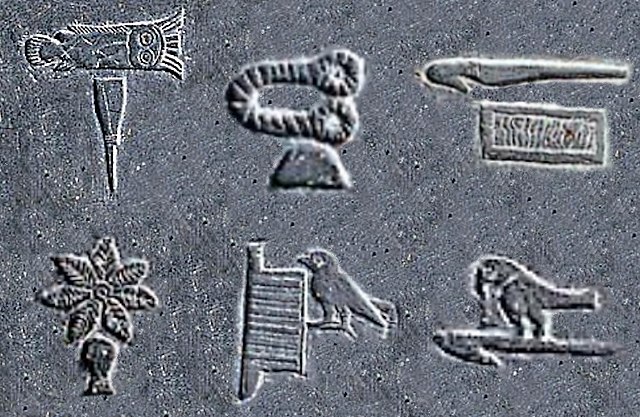The Narmer Palette, also known as the Great Hierakonpolis Palette or the Palette of Narmer, is a significant Egyptian archaeological find, dating from about the 31st century BC, belonging, at least nominally, to the category of cosmetic palettes. It contains some of the earliest hieroglyphic inscriptions ever found. The tablet is thought by some to depict the unification of Upper and Lower Egypt under the king Narmer. Along with the Scorpion Macehead and the Narmer Maceheads, also found together in the main deposit at Nekhen, the Narmer Palette provides one of the earliest known depictions of an Egyptian king. On one side, the king is depicted with the bulbed White Crown of Upper (southern) Egypt, and the other side depicts the king wearing the level Red Crown of Lower (northern) Egypt, which also makes it the earliest known example of a king wearing both types of headdress. The Palette shows many of the classic conventions of Ancient Egyptian art, which must already have been formalized by the time of the Palette's creation. The Egyptologist Bob Brier has referred to the Narmer Palette as "the first historical document in the world".

Both sides of the Narmer Palette
Early hieroglyphic symbols on the Narmer Palette
Narmer Palette (recto)
Narmer Palette (verso)
Cosmetic palettes are archaeological artifacts, originally used in predynastic Egypt to grind and apply ingredients for facial or body cosmetics. The decorative palettes of the late 4th millennium BCE appear to have lost this function and became commemorative, ornamental, and possibly ceremonial. They were made almost exclusively out of siltstone with a few exceptions. The siltstone originated from quarries in the Wadi Hammamat.
The "Four dogs Palette", Room 633 of the Louvre.
Fragment of a ceremonial palette illustrating a man and a type of staff. Circa 3200–3100 BCE Predynastic, Late Naqada III.
Fragment of a palette 3200-2800 BCE
Palette in the shape of a boat, 3700-3600 BCE, Naqada I.








